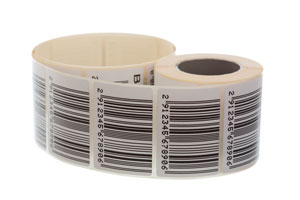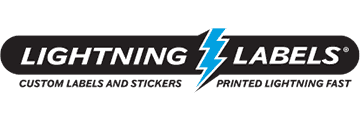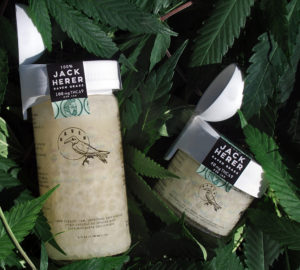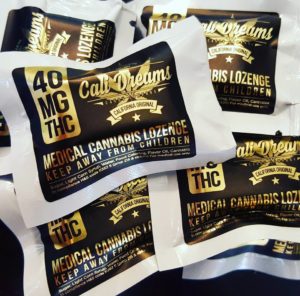Member Blog: Stellar Customer Service, Transparency, & Education Drive Cannabis Success

by Gary Paulin, VP of Sales and Client Services at Lightning Labels
With expansive product choices, it’s no longer enough to rely solely on product quality and availability. Today’s maturing cannabis marketplace requires differentiation to resonate and succeed.
Three pillars of that differentiation are stellar customer service, total transparency, and excellent education. At the core of each, sincerity and truth must predominate. In this age of “fake news,” anything that doesn’t seem trustworthy and true likely will backfire on the company sooner or later.
It only takes one unsubstantiated quality control or product claim to hit the social media lie detector, then potentially go viral. At the very least, one consumer badmouthing your company via word-of-mouth and/or digital messaging will harm your reviews and ratings. In most cases, the damage will be undetectable until it reaches a level where revenues and reputation are noticeably impacted.
Following are four basics of stellar customer service, transparency, and education:
-
Interact authentically. Scripts and canned phrases instinctively don’t resonate with most consumers. One obvious example is the “I’m so sorry you’re having a problem” response. How likely is it that the person is really sorry and not just parroting something they’ve been told to repeat time and time again? Instead, communicate in a real way by tuning into what the existing or prospective customer is trying to address.
For example, when someone complains about lengthy waits to receive live phone support (including disconnects while waiting), it’s okay to say something like, “I get it. We’ve been having challenges. Now that we’re on the phone together, let’s address your needs right away. And, please give me your phone number, just in case this call drops. I’ll call you right back.”
-
Offer multichannel communications preferences. Some people want live phone support, not a digital option. Chat bots can be extraordinarily frustrating unless the programming and ability is advanced. Ditto for “live chat.” As much as possible, make it easy and meet everyone’s preferences. Email, live phone support, texting, website knowledge center, and digital chat should all be offered to meet the customer in a way that works best.
-
Offer total and transparent education. Knowledge centers (and associated forums) and FAQs can be excellent tools to help provide priority information, but they’re only one piece of the puzzle. Consumer questions and concerns can cover anything. There should be an easy way to find more information through the above-referenced channels as needed. Product labels can provide easy access to a variety of information, starting with label content and extending to either Augmented Reality or QR digital gateways for more in-depth education. Those digital gateways should contain valuable information, along with easily found follow-up calling, emailing, live chat, and additional educational options (including possibly Knowledge Center, FAQs, and keyword-search forums/articles, et al).
“Full disclosure” should be at the core of all things educational, both in information repositories and customer service support. For example, CBD can make some people cranky and anxious. Full disclosure must override the desire to sell. By fully informing a consumer of risks as well as rewards, the experience is much more likely to result in high marks for the company.
Conversely, incomplete or inaccurate information provided by salespeople motivated only by making sales will backfire when less than optimum outcomes occur. In contrast, a salesperson willing and able to fully educate will help build long-term customer relationships with the company.
-
Hire motivated, attentive, smart people. No matter what policies and training are in place, ultimately companies need to focus on hiring the best candidates — those dedicated to top-notch customer service, truthtelling, and education. Workforce shortages are not a valid reason to abandon these core values in the name of expedient hiring. Be committed to employee wants and needs, and be prepared to follow through. Offer generous wages, but beware of those who seem overly money motivated and demanding. They likely will be gone as soon as the next “shiny toy” opportunity comes along.
There are companies that have weathered supply chain and workforce shortage issues — and even inflationary pressures — well. One that comes to mind is Costco. Unlike many retailers during the pandemic, their quality of service has remained high. Product availability and selection have been maintained. Prices, although subject to some upward movement, don’t seem to have risen as much as most retailers.
Clearly, Costco found solutions instead of blaming challenging conditions and using those as an excuse for failure. Follow this example. Find ways to do more with less, get creative about becoming more efficient, and plan ahead so that emergent problems don’t become overly taxing.
Cannabis companies that excel in being trusted, liked, and respected will outperform their competitors willing to live with mediocrity.
 Gary Paulin is VP of Sales and Client Services at Lightning Labels, a Denver-based custom label printer that uses state-of-the-art printing technology to provide affordable, full-color custom labels and custom stickers of all shapes and sizes. Contact: sales@lightninglabels.com; 800.544.6323 or 303.481.2304.
Gary Paulin is VP of Sales and Client Services at Lightning Labels, a Denver-based custom label printer that uses state-of-the-art printing technology to provide affordable, full-color custom labels and custom stickers of all shapes and sizes. Contact: sales@lightninglabels.com; 800.544.6323 or 303.481.2304.
Member Blog: Cannabis Supply Chain Roadmap – Control What You Can, Plan For The Rest

by Gary Paulin, VP of Sales and Client Services at Lightning Labels
In a world where instant gratification has run headlong into supply chain snafus and delays, something has to give. In the cannabis industry, the keys to success are to control what you can and plan for what you can’t.
Being proactive, creative, and resourceful are the keys. Cannabis purveyors are facing shortages of products and packaging. Shipping challenges, both from suppliers and to consumers, also are in the mix. And, with consumer demand through the roof, competition for fewer supplies available in a timely manner has become superheated.
What can cannabis companies do to maximize customer satisfaction while minimizing stress levels at this critical time?
The short answer can be found in the Serenity Prayer, which states in part: “God, grant me the serenity to accept the things I cannot change, courage to change the things I can, and wisdom to know the difference.”
In short, take and keep control of what you can realistically control, do contingency planning for occurrences out of your control, and know the difference between the two. One example of how to keep control: Companies facing potential shortages in many cases can build up inventory of available products, including labels, containers, and the like. Extra costs involved in doing this can be substantial, but compared to not being able to fulfill orders and having to deal with consequences — including falling revenues and workplace stress — it can be a relatively small price to pay.
One example of how to do contingency planning: Cannabis companies not in direct control of manufacturing everything that goes into a product need to figure out workarounds. In some cases, this may include advising consumers of potential looming shortages. In others, finding substitute sources that can step in if needed may be well worth the time it takes to do the research.
Again, this may cost more, but at this critical time, cannabis companies need to compare that to the cost of not doing it.
Following are specific steps cannabis companies can take to stay on top of supply chain snafus:
- Determine what suppliers are clearly able and willing to meet your needs. In the label world, for example, talk with your supplier to look at likely needs through at least the first quarter of 2022. Make this company your proactive partner to offer insights about the best strategies to ensure you’ll have what you need when you need it. In some cases, this is as easy as knowing they will carry adequate supplies and perform well because they think and work ahead. In others, work with the supplier to figure out options that can substitute for something that may be in short supply.
- Ramp up customer service efforts. No matter how supply chain challenges are impacting your company, spend extra time and effort to keep your customers happy. Often, frustrated or demanding customers can be made happier with sincere, empathic customer service. In addition, where possible, be proactive with customers about what they’re willing to tolerate (e.g., longer turnaround in exchange for lower price). By assessing, then fully addressing, customer needs, you can achieve positive reviews and enhance reputation by showing your ability to tune into their needs. Be real and follow through on commitments. There’s almost nothing worse than promising performance, then not delivering. If you tell them you’re going to do something, including contacting them back, do it when you say you will.
- Make shipping as predictable as possible. Both for incoming and outgoing, figure out what you can expect (e.g., transportation directly under your control), and where you’ll need to rely on third-party shipping. Do some research about shippers to identify emergent issues, talk to your regular shippers about what to expect/plan for, and find substitute solutions if needed. You may also have to factor in higher shipping costs, at least through the first quarter of 2022.
- Research buying trends into near-to-mid-term planning. High consumer demand is here to stay, at least for a while. As best you can, figure out what the next few months are looking like, factoring in buying demand specific to cannabis as well as the bigger global picture. Between the pandemic roller coaster, economic volatility, political and social upheaval, and proliferation of severe weather destruction and disruption, there is much beyond the realm of cannabis that may impact buyer demand and the supply chain for months, if not years.
- Build in breathing room where possible. Such options as subscribe-and-save and discounts for orders with longer lead times are two measures that can take pressure off cannabis companies to a certain extent. Following the lead of such companies as Amazon, provide incentives for discounts when customers select longer lead times or commit to a regular ordering pattern.
 Gary Paulin is VP of Sales and Client Services at Lightning Labels, a Denver-based custom label printer that uses state-of-the-art printing technology to provide affordable, full-color custom labels and custom stickers of all shapes and sizes. Contact: sales@lightninglabels.com; 800.544.6323 or 303.481.2304.
Gary Paulin is VP of Sales and Client Services at Lightning Labels, a Denver-based custom label printer that uses state-of-the-art printing technology to provide affordable, full-color custom labels and custom stickers of all shapes and sizes. Contact: sales@lightninglabels.com; 800.544.6323 or 303.481.2304.
Member Blog: Augmented Reality CBD, Cannabis Product Labels – Entertainment Paves Path to Education

by Gary Paulin, VP of Sales and Client Services at Lightning Labels
Everyone loves good, entertaining stories. In part, their value lies in information — and education — sticking with recipients long after the storytelling has ended.
There’s a correlation in this to the value of Augmented Reality (AR) CBD and cannabis labels — which provide a novel, entertaining way to capture and keep audience attention. Along the way, product-makers have an opportunity to provide credibility-enhancing education about products, trends, quality control, and the like.
More than ever, consumers want to feel their products protect them. Likewise, cannabis and CBD manufacturer reputation and revenues hinge on consumers feeling safe using their products, and clear about proper (and improper) uses.
Augmented Reality brings interaction and product labeling together, using smart device apps, and even your smart phone’s camera to create an enhanced user experience. When viewers download a related smartphone app and point it at the product’s label, they can see an array of different options including videos, 2D/3D content, social media sharing options, and content that enables seeing how products appear in the real world. A web-based interaction can be launched using your phone’s camera – just open your camera app and point it toward a QR code. In either case, the AR experience is initiated, and interacting with brand labels this way is fun, interesting, and can be extremely educational.
In many ways, it’s like hearing and seeing a story. When connected to useful, practical educational information, AR can fully address common and compelling consumer concerns at a time when fears about safety and health are at an all-time high.
In turn, this can assist manufacturers looking to gain another competitive edge when it comes to consumer awareness, preference, and sentiment. This further strengthens the labels’ role as the front door to product marketing and sales.
TrendHunter.com, dedicated to trend identification, notes that AR is gaining popularity in a variety of industries, ranging from food and beverage to cannabis. Regarding labels, the site notes: “The food and beverage industry adopts augmented reality-based labels… The use of AR in food labels is on the rise, with brands using such technology to both engage and educate their customers on the products they’re considering, or have already purchased. Such items cater to consumers’ continued interest in gamification, and add an element of interactivity that tends to be limited in product packaging.”
TrendHunter.com continues: “Though consumers tend to go online and research the details pertaining to products they purchase, the amount of information to sort through can be overwhelming. Thus, having brands do some of the work in relation to product education allows consumers the freedom to purchase in-person. With tech-integrations into labeling and packaging, this process is streamlined for consumers.”
Specifically targeting cannabis, TrendHunter.com emphasizes: “Virtual and augmented reality enters the cannabis space… The merging of augmented and virtual realities with the cannabis industry is on the rise as brands look to offer immersive experiences for connoisseurs and beginners alike. These platforms offer benefits like virtual product libraries and augmented package engagement — prioritizing both informative and creative experiences for viewers… For novice consumers, being informed about this emerging space is crucial in order to alleviate some of the apprehension they feel when they’re considering consuming a substance that was once attached with stigma and misinformation.”
Here are some hands-on, straightforward ways that AR-powered cannabis and CBD product labels can engage and educate consumers:
- Show products being manufactured, establishing quality controls, purity and other credibility-building examples along the way;
- Relate customer stories and reviews endorsing products, benefits and efficacy;
- Address claims and controversies within the industry or involving the company itself;
- Document complete tracking of products from seed to shelf, proving authenticity and quality control;
- Provide ways (and encouragement) for consumers to interact with a brand via AR;
- Offer easy social media sharing options, so that individual consumers can become brand information hubs via their networks.
 Gary Paulin is VP of Sales and Client Services at Lightning Labels, a Denver-based custom label printer that uses state-of-the-art printing technology to provide affordable, full-color custom labels and custom stickers of all shapes and sizes. Contact: sales@lightninglabels.com; 800.544.6323 or 303.481.2304.
Gary Paulin is VP of Sales and Client Services at Lightning Labels, a Denver-based custom label printer that uses state-of-the-art printing technology to provide affordable, full-color custom labels and custom stickers of all shapes and sizes. Contact: sales@lightninglabels.com; 800.544.6323 or 303.481.2304.
Member Blog: ‘Topsy-Turvy’ Is The Name Of The Game In Cannabis

By Gary Paulin, Lightning Labels
Now you see it. Now you don’t. What’s in compliance today may run afoul tomorrow. And federal government wishes and whims continue to cast a pall over state operations.
In this topsy-turvy environment, cannabis purveyors need to be able to pivot on a dime. Everything from labeling requirements to product track-and-trace regulations can change quickly.
Recent events in Utah illustrate topsy-turvy in action. First, the electorate approved medical marijuana on the ballot last fall. Then, the state legislature stepped in and passed a bill that overhauls the provisions in an effort to tighten up controls. On Valentine’s Day, Fox 31 in Salt Lake City reported that all of Utah’s major health care organizations will show some love, allowing physicians to recommend medical cannabis. This report follows an announcement of another bill being introduced that would tweak the provisions of the just-passed law.
Still with me? OK, there’s more. In late February, Utah’s Daily Herald reported, “The Utah County Planning Commission decided Tuesday to delay a potential recommendation to amend land use ordinances to allow for cannabis production… The delay came at the request of Robert Moore, deputy county attorney, who asked for a decision to be delayed by three months in order to see if additional legislation on medical marijuana comes before the state this legislative session and to give time for the Utah Supreme Court to review a case questioning if the Utah Medical Cannabis Act passed in a special legislative session in 2018 or if the voter-approved Proposition 2 should be current law.”
The same day, Fox 31 reported, “An attorney representing a pair of groups suing the state over the new medical cannabis law is warning cities and counties that Utah is essentially creating a state-run drug cartel.”
Takeaways for cannabis purveyors in other ‘newbie’ states
Obviously, Utah has a lot of sorting out to do before anything gets solidified. However, this roller-coaster sequence of events can serve to educate (and warn) purveyors in other states where cannabis has been legalized to get and stay on top of all the latest twists and turns. Failure to do so can easily catch someone in a compliance shortfall that can threaten or even close down their business.
- Get the right people in the right spots on the bus. Big-picture thinkers and cannabis companies go hand-in-hand. While innovative, expansive thinking can be critical to a successful company launch, detail-oriented thinkers are essential to oversee and develop effective policies and follow-through in every major department—including administration, operations, legal, accounting and marketing/branding. In a complex, rapidly-changing industry such as cannabis, being nitpicky is a major asset.
- Find resources providing up-to-date compliance and regulation information. One helpful resource is a report entitled, “Cannabis Packaging and Labeling Regulatory Recommendations for States and Nations,” developed by the Council on Responsible Cannabis Regulation and the National Cannabis Industry Association. There also are organizations specializing in compliance and regulation information for municipalities and states. No matter what resources are accessed, it’s always a good idea to confirm information by directly checking applicable municipal and state information centers. This is especially important given the dynamic changes occurring in the cannabis industry.
- Designate go-to trusted advisors inside/outside the company to handle various challenges rapidly. At the outset, draw up a list of advisors who can provide expert advice on-the-spot when needed. In some cases, these may be the same people listed in #1 above. In other cases, more specialized resources may be required. For example, you may hire a cannabis-savvy lawyer to develop/oversee your business structure, partnership agreements and the like. Another legal eagle may be brought in to deal with such real estate-related issues as the buying/leasing of property and buildings. Yet another attorney might be on call when compliance or regulation questions arise.
- Build in agility. Cover all the bases, but keep them fluid. For example, in the branding world, development of labels and packaging is a cornerstone priority that should be addressed in a thoughtful and in-depth way. But, then what happens if a state regulation altering label disclosures or packaging comes down with a short compliance lead time? You’ve got to be ready to hit the ground running both to comply and make your continued branding efforts all they can be.
 Gary Paulin is Director of Sales and Client Services for Lightning Labels, a Denver-based label printer that has been offering state-of-the-art affordable, full-color custom labels and custom stickers of all shapes and sizes to cannabis purveyors for more than a decade. They offer many options for materials and laminates and special effects to achieve digital short-run requirements (50 minimum) on up to 15 million labels, plus Lightning fast delivery. For more information and to place orders online, visit LightningLabels.com. For the latest in packaging news and labeling promotional offers, find Lightning Labels on, Facebook, Instagram, Twitter (@LightningLabels), Pinterest, Google+ and LinkedIn.
Gary Paulin is Director of Sales and Client Services for Lightning Labels, a Denver-based label printer that has been offering state-of-the-art affordable, full-color custom labels and custom stickers of all shapes and sizes to cannabis purveyors for more than a decade. They offer many options for materials and laminates and special effects to achieve digital short-run requirements (50 minimum) on up to 15 million labels, plus Lightning fast delivery. For more information and to place orders online, visit LightningLabels.com. For the latest in packaging news and labeling promotional offers, find Lightning Labels on, Facebook, Instagram, Twitter (@LightningLabels), Pinterest, Google+ and LinkedIn.
Member Blog: Know Your Regulations, Know Your Labels

by Gary Paulin, Director of Sales of Lightning Labels
Agility, timely data and printing performance drive cannabis label compliance
Ability to move quickly, accurately, and competitively is the lifeblood of cannabis purveyors. Timely compliance in such areas as labels and packaging is critical to staying in business; agility in grabbing a competitive edge is crucial to profitability.
To help make that happen, cannabis-savvy label experts must be able to provide near real-time information and clear, straightforward guidance to ensure full and timely compliance. With labeling and packaging regulations constantly changing across the land, getting and staying current is much easier said than done.
Sweeping changes include revising labels to make cannabis products less appealing to children, listing THC and CBD amounts, designating “hemp” versus “marijuana” products, and establishment of label regulations in states with new marijuana legalization laws. Then, there’s the entire country of Canada, which will legalize recreational marijuana effective October 2018.
California purveyors in particular are feeling the heat. New packaging and label regulations went into effect July 1, and Proposition 65 rules impacting all product labeling and packaging are now in force (full compliance deadline was Aug. 30).
Critical consequences of non-compliance
California’s July 1 requirements alone proved difficult for a variety of cannabis companies. A report on KPIX, the San Francisco Bay Area CBS affiliate, pointed out: “Empty Shelves At Some Bay Area Pot Dispensaries After New July 1 Label Law… Many California marijuana dispensaries seeing their profits are going up in smoke. Their shelves are sitting empty ever since a new labeling law took effect Sunday… the Associated Press estimated the entire industry would lose nearly $400 million because of unsold product.”
Obviously, lack of knowledge and compliance can carry severe penalties, crippling operations and hobbling profits. Here are a few tips to help cannabis companies stay on top of evolving labeling and packaging regulations and avoid regulatory repercussions:
Partner with companies providing accurate and complete label and packaging guidance, both on the information and hands-on production and printing fronts. There are companies dedicated to maintaining current and complete databases about rules and regs in municipalities and states where both medical and recreational marijuana laws are in effect. And there are label production and printing companies with extensive track records in creating cannabis labels. Make sure you get up to speed in both areas.
Confirm “agility ability” of these entities. All the information and capabilities in the world can be for naught if the capacity for executing quickly and competently doesn’t exist. As the cannabis industry continues to twist and turn all over the place, including labeling and packaging requirements, it’s absolutely critical to be able to move with—or optimally ahead of—developments. Having consistent, reliable resources in place can make the difference between plentiful shelves and profits and the emptiness associated with non-compliance—as many California purveyors discovered the hard way.
Use these established resources for predictive modeling. While predicting the future of cannabis rules and regulations may be difficult, cannabis companies with access to ample intel, experience and expertise may be able to better prepare for the future. Information showing trends, innovative ways to address what’s ahead with labels and packaging that “think ahead of the curve,” and overall insights into a variety of marketplaces can help make this happen.
 To address both branding/printing and business/legal intelligence requirements at state and local levels, Denver-based strategic partners Lightning Labels and Highmark Data are giving cannabis purveyors fast and agile one-stop access to much-needed resources pertaining to labels and packaging. Lightning Labels is a Denver-based label printer that has been offering state-of-the-art affordable, full-color custom labels and custom stickers of all shapes and sizes to cannabis purveyors for more than a decade. Highmark Data provides comprehensive business and legal intelligence needed to make the smartest and most compliant decisions in municipalities and states nationwide.
To address both branding/printing and business/legal intelligence requirements at state and local levels, Denver-based strategic partners Lightning Labels and Highmark Data are giving cannabis purveyors fast and agile one-stop access to much-needed resources pertaining to labels and packaging. Lightning Labels is a Denver-based label printer that has been offering state-of-the-art affordable, full-color custom labels and custom stickers of all shapes and sizes to cannabis purveyors for more than a decade. Highmark Data provides comprehensive business and legal intelligence needed to make the smartest and most compliant decisions in municipalities and states nationwide.
Gary Paulin is Lightning Labels’ Director of Sales and Client Services.
Member Blog: Belly Up to Cannabis Barcode Labels
by Mark Lusky, Lightning Labels
In an increasingly hostile marijuana environment championed by Attorney General Jeff Sessions, tracking of marijuana from “seed to sale” is more critical than ever. All other threats aside, if you can’t document it, you’re in trouble.
And, that’s not just at a federal level. In an effort to document total compliance and control of this rapidly-growing industry, states have taken it upon themselves to require comprehensive due diligence from all cannabis purveyors.
Forbes magazine addresses this in a recent article entitled, “Tracking America’s Cannabis Industry Through Big Data.” Citing Colorado, the article states in part, “This harnessing of an information technology to track the cannabis market is key to Colorado’s forceful march towards creating a thriving legal marijuana industry. Crucially, the state’s ability to use tracking and Big Data could provide a reference point for other jurisdictions interested in the regulatory potential offered by tracking. This ‘closed loop’ ‘seed to sale’ inventory tracking system embodies a ‘full traceability’ mode…”
The article continues, “The use of tracking as a regulatory device is expanding, operating in Oregon, Maryland and Alaska. There are other cannabis tracking companies such as MJ Freeway operating in Nevada and BioTrackTHC in Washington, New Mexico, Illinois, New York, and Hawaii. After all, tracking is part of day to day life. We track parcels and Uber drivers with our phones while retailers track us through those pesky cookies on our computers. Whatever the context, whether it is a regulator or us doing the tracking or whether it is marijuana or us being tracked, the technology is an essential part of contemporary commercial and regulatory life.”
Cannabis Barcode labels to the rescue
 An established staple in retail and inventory environments, barcodes/QR codes facilitate trackability. Now that message is resonating in the cannabis industry. A primer in motherboard.vice.com points out, “Walk into any licensed cannabis grow op in Colorado and one of the first things you’ll notice are the barcodes.” They point out in another article, “There are a number of advantages of having a bar code for cannabis growers, producers and retailers. The most important is proper inventory control – which is mandated, in Washington, by the Washington State Liquor Control Board. Having bar codes on inventory items allows rapid identification of specific SKUs. The likelihood of inventory quantity irregularities is greatly reduced.”
An established staple in retail and inventory environments, barcodes/QR codes facilitate trackability. Now that message is resonating in the cannabis industry. A primer in motherboard.vice.com points out, “Walk into any licensed cannabis grow op in Colorado and one of the first things you’ll notice are the barcodes.” They point out in another article, “There are a number of advantages of having a bar code for cannabis growers, producers and retailers. The most important is proper inventory control – which is mandated, in Washington, by the Washington State Liquor Control Board. Having bar codes on inventory items allows rapid identification of specific SKUs. The likelihood of inventory quantity irregularities is greatly reduced.”
They also emphasize, “The reasoning behind implementing these cannabis surveillance systems is pretty straight forward. Since cannabis is still illegal on a federal level, the burden is on the states that have legalized weed to prove that legalization has not aided black market activity.”
Systems spring up to support tracking
Regardless of what type of cannabis tracking label is used, sophisticated systems are springing up to oversee the entire process. An article in the Cannabis Industry Journal entitled “The Importance of Traceability” cites insights of Cody Stiffler of BioTrackTHC, one such system, at a Cannabis Labs Conference in 2016: “The primary goals of a traceability system, according to Stiffler, are to prevent diversion and promote public safety. Our software helps get safe products to patients and consumers in a responsible manner. BioTrackTHC’s tracking software covers everything from seed to sale, involving regulatory bodies in oversight. In the beginning of cultivation, each plant is assigned a bar code or sixteen-digit identifier.”
While “location, location, location” is the driver in real estate, “tracking, tracking, tracking” is the name of the game in the cannabis industry.
Mark Lusky is a marketing specialist who has worked with Lightning Labels since 2008. Lightning Labels uses state-of-the-art printing technology to provide affordable, full-color custom labels and stickers of all shapes and sizes, along with barcode labels and consecutive numbering. From small orders for individuals, to the bulk needs of big businesses, Lightning Labels is equipped to handle and fulfill custom label and sticker projects of all types. Lightning Labels was established in 2002 and based in Denver, Colorado.
Member Blog: Cannabis Branding Faces Uncertain Future
 by Mark Lusky, Lightning Labels
by Mark Lusky, Lightning Labels
When it comes to cannabis labels and cannabis packaging, and for that matter everything branding-related, the marijuana industry is a many-splendored riddle. On one hand, the industry’s avant-garde nature and offerings lend themselves to eclectic and eccentric designs. On the other hand, a demand-heavy marketplace, lack of branding sophistication, and fears about sinking too much branding money into federally illegal enterprises have stifled forward progress.
 At the same time, states with the longest track record of legal use have evolved in many cases to higher levels of professionalism and panache on such important elements as marijuana labels and packaging.
At the same time, states with the longest track record of legal use have evolved in many cases to higher levels of professionalism and panache on such important elements as marijuana labels and packaging.
An August 2016 article in HighTimes.com assesses the state of the struggle: “A lot of goofy business names, awkward brand identities, poor design execution and amateur packaging solutions have been the norm…for cannabis companies up until recently, when increasing sophistication among those investing and working in this nascent industry resulted in more slick presentations, upscale appeal and mass market sales. After all, research suggests that 33 percent of all sales are influenced by branding and packaging.”
An article published on Entrepreneur.com in January points to hiccups across the board, noting that, “Businesses traditionally developed strong brands in logos, typography, color and composition. The idea was to become as ubiquitous and familiar as Hershey, Band-Aids or Scotch Tape. Left to web designers, cannabis businesses have yet to produce that attention grabber.”
Federal illegality creates consternation, conservative strategies
All along, marijuana has remained illegal under federal law, creating lots of confusion as well as a conservative approach to spending money on such branded items as marijuana labels and marijuana packaging. Illegality has impacted a wide swath of practices in such sectors as taxation and banking.
 Cannabis companies have been reticent to sink too much money into endeavors that can’t be federally trademarked or patented for fear of being copied. Notes the Sacramento Record-Bee in a January article, “Branded pot products gained footing in recent years as California sanctioned medical use of marijuana, and other states began permitting recreational use. Now that California voters have approved a ballot measure allowing all adults to use the drug, cannabis businesses want more authority to brand their products…But officially trademarking marijuana is a tricky legal task. The federal government still considers it an illegal drug, and won’t grant patents or trademarks for pot or anything made from it. Cannabis brands fear they are at risk of being copied. So marijuana businesses in California—eyeing what could become a $6.4 billion industry—have turned to the state government for help.”
Cannabis companies have been reticent to sink too much money into endeavors that can’t be federally trademarked or patented for fear of being copied. Notes the Sacramento Record-Bee in a January article, “Branded pot products gained footing in recent years as California sanctioned medical use of marijuana, and other states began permitting recreational use. Now that California voters have approved a ballot measure allowing all adults to use the drug, cannabis businesses want more authority to brand their products…But officially trademarking marijuana is a tricky legal task. The federal government still considers it an illegal drug, and won’t grant patents or trademarks for pot or anything made from it. Cannabis brands fear they are at risk of being copied. So marijuana businesses in California—eyeing what could become a $6.4 billion industry—have turned to the state government for help.”
Given the uncertain direction that federal enforcement will take under the new administration and anti-marijuana attorney general, it’s anyone’s guess about if, how, when, and where cannabis branding will move forward.
Following are tips for cannabis companies addressing or reviewing their branding currently:
- Look at purveyors/competitors in “pioneering” states that have the longest track record–to see how they have evolved their branding. Typically, Colorado and Washington are at the top of states where both recreational and medicinal are legal; California is a strong state for medicinal. After seeing what’s out there, decide on a path for yourself;
- Match the design sophistication to the appropriate graphics team. In most cases, this means finding a branding specialist—not a one-size-fits-all web developer whose shingle includes the word “design;”
- Protect the intellectual property through state and other non-federal regulations/laws where possible.
Given the omnipresent threat of federal intrusion in the overall operation, figure out what you can stand to lose upfront, spend accordingly, and keep your fingers crossed.
Lightning Labels uses state-of-the-art printing technology to provide affordable, full-color custom labels and stickers of all shapes and sizes. From small orders for individuals, to the bulk needs of big businesses, Lightning Labels is equipped to handle and fulfill custom label and sticker projects of all types. Lightning Labels was established in 2002 and based in Denver, Colorado. Mark Lusky is a marketing specialist who has worked with Lightning Labels since 2008.

 Gary Paulin is VP of Sales and Client Services at Lightning Labels, a Denver-based custom label printer that uses state-of-the-art printing technology to provide affordable, full-color custom labels and custom stickers of all shapes and sizes. Contact: sales@lightninglabels.com; 800.544.6323 or 303.481.2304.
Gary Paulin is VP of Sales and Client Services at Lightning Labels, a Denver-based custom label printer that uses state-of-the-art printing technology to provide affordable, full-color custom labels and custom stickers of all shapes and sizes. Contact: sales@lightninglabels.com; 800.544.6323 or 303.481.2304.

 Gary Paulin
Gary Paulin


 To address both branding/printing and business/legal intelligence requirements at state and local levels, Denver-based strategic partners
To address both branding/printing and business/legal intelligence requirements at state and local levels, Denver-based strategic partners 

